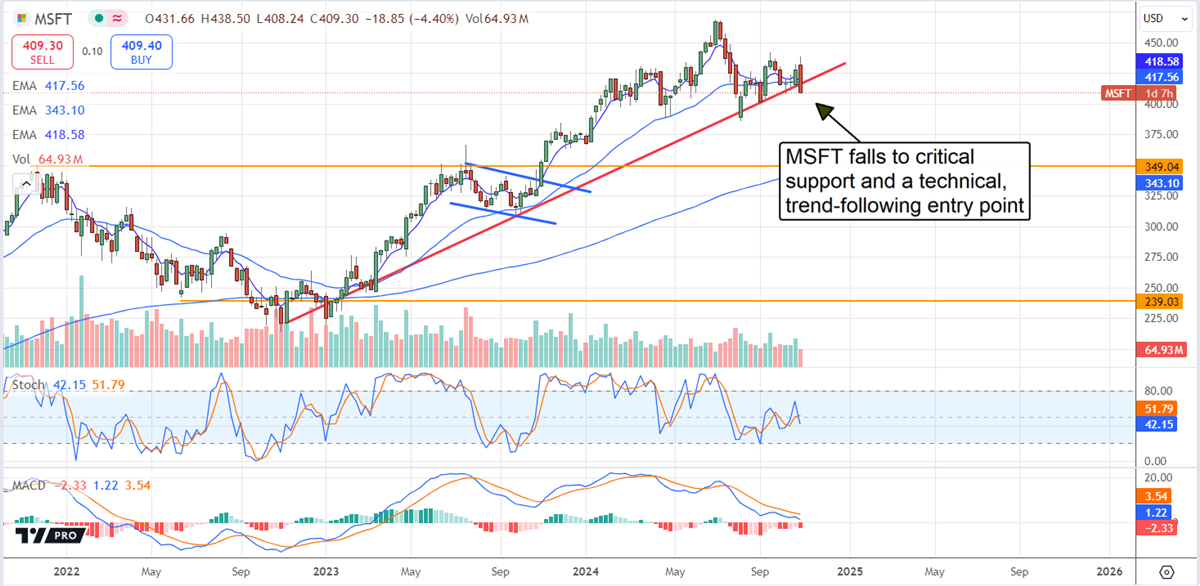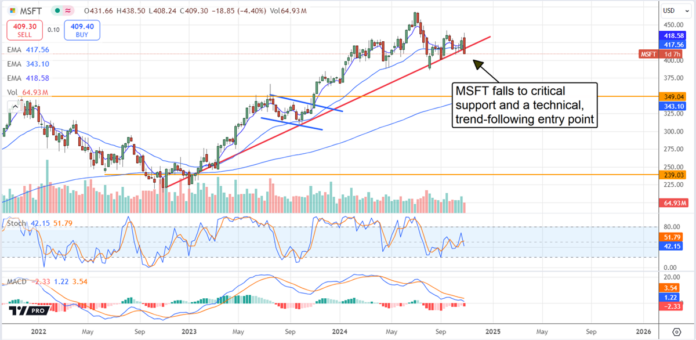Microsoft’s (NASDAQ: MSFT) stock recently experienced a dip, presenting a potential buying opportunity after its fiscal Q1 2025 earnings report. The decline mainly stems from a lowered growth outlook for Azure in Q2 and increased expectations around AI investments. However, the overall message remains optimistic: robust growth continues, future guidance appears cautious, and it seems that the revenue has simply been delayed rather than lost. Key factors impacting this situation include postponed data center construction caused by GPU and CPU supply issues, with projections suggesting a gradual improvement in supply and demand.
Solid Earnings Support Microsoft’s Stock Uptrend
Microsoft’s FQ1 results reveal strong performance with net revenue reaching $65.6 billion, a 16.1% increase that surpassed analyst expectations by 160 basis points. This growth is noteworthy across all business segments. Additionally, more than 90% of analysts had increased their estimates during the quarter, indicating that expectations were high. The company also demonstrated sequential and year-over-year revenue growth, positioning itself well for Q2.
Segment performance was particularly impressive: Productivity & Business rose by 12%, More Personal Computing increased by 17%, and the critical Intelligent Cloud surged by 20%. Notably, Azure saw a 33% growth, exceeding the consensus by 400 basis points, while the overall cloud segment achieved a net growth of 28%.
On the margin side, GAAP EPS was reported at $3.30, up by 10% year-over-year (YoY), beating forecasts by $0.20. Microsoft maintained strong margins despite rising costs, showing a 14% increase in operating income and net income of $24.7 billion. The company generated positive cash flow once again, and its solid financial position shows improved assets, decreased liabilities, and enhanced equity. Shareholder equity has grown by 2% and is expected to improve as the fiscal year progresses.
Cautious Guidance Affects Investor Sentiment
The cautious guidance provided by Microsoft is the primary concern impacting its stock price. While Azure is projected to grow by 31% to 32% along with upward forecasts for other segments, this marked a decrease from preceding guidance. Nonetheless, the cautious approach seems appropriate in light of strong business momentum and heightened AI investments across the tech industry. High demand for computing and AI efficiency remains, leaving supply issues as the main hindrance for Microsoft at this time.
Events such as NVIDIA’s upcoming fiscal Q3 earnings release and their Q4 guidance may influence market perspectives. Furthermore, the CQ3 report from Meta Platforms (NASDAQ: META) could provide a favorable backdrop for Microsoft’s future results, possibly leading to better outcomes than anticipated. An indication from NVIDIA (NASDAQ: NVDA) regarding improved GPU and CPU supply would also be a positive development. Meta, as a Microsoft client, utilizes its services for various operational needs including data centers and AI workloads. Highlights from Meta’s report suggest an increase in AI spending forecasts, which aligns with current trends.
Analysts Respond: New All-Time Highs On the Horizon
Analyst responses to Microsoft’s news are mixed, showing equal numbers of target increases and decreases. The overall effect has been a slight reduction in the consensus target price, although the lowest target aligns with crucial support at a significant uptrend line. This suggests a potential floor for the stock, with the consensus indicating a 15% upside from that level and the possibility of reaching new all-time highs.
Technically, the setup for Microsoft appears favorable, as stock prices remain in a strong upward trend. The recent pullback brought prices to key indicators, including a cluster of moving averages and the uptrend line. If the market responds positively to this opportunity, support should be established shortly after the report, paving the way for higher prices this year. Conversely, if the stock fails to maintain this trend, shares may slip to $390 or lower before reaching solid support.

The views and opinions expressed herein are the views and opinions of the author and do not necessarily reflect those of Nasdaq, Inc.

